Porcelain Insulator News
by Elton Gish, NIA #41
Reprinted from "Crown Jewels of the Wire", June 1987, page 15
There have been a few reports dribbling in over the last several years of
insulators which required the assignment of a new U-number. The reports were too
few to cause much excitement among porcelain collectors.
The many new reports recently received are very exciting indeed and go to prove that
the possibility of finding
new porcelain styles is not so remote as one might think. Albeit that some of you have an unreported
style in your
collection.
Jack Tod has been busy assigning U-numbers and making the final ink drawings
of the new styles. Not all of the new styles will be reported this month. Future
reports will show three styles of pin-posts, a new Imperial crosstop, an
exchange and a glazeweld style. Also in the works is the answer for the use of
the oddball whatisit insulator last reported in February CJ. Somewhere in all
this you can expect to read the success story of Robert Winkler's 15 year search
of the elusive spiral insulator.
As a reminder, the shadow profile method that is used to accurately describe
a new style (so a final drawing can be made and U-number assigned by Jack) is
very easy and quick to make. The profile method appeared in the December, 1984
issue of CJ or, if that issue is not available to you, I will be glad to send
you a copy of the simple procedure.

The last new style of Macomb reported in April, 1986 CJ was U-244B, thirteen
years after the last reported new Macomb style (U-244A). Steve Fujimoto has
found a new Macomb that is a strong contender for "find of the year".
Jack has assigned it U-599B. The insulator has the typical Macomb mold lines for
these dry process units. The embossed Macomb marking is positioned horizontally
about mid-way down the body of the insulator between the tie-wire groove and the
bottom edge of the outer skirt. This crown type cable insulator style was later
manufactured by the wet process method (after the dry process pin types were
discontinued in 1915) as illustrated in the Illinois Electric Porcelain Co.
catalog of 1918 and in a 1920 advertisement.
Bob Lanpher (NIA #487) reported a most unusual find at a local flea market!
The photo below shows that the number thirteen is not Bob's unlucky number. All
but the two white units on the bottom row are Fred Locke porcelain. None of the
units show any sign of being used. All of the Locke units are in pristine
condition except for slight recent damage on one. The ink markings are
exceptional! These insulators were surely hand picked from the production line
at Fred Locke's Victor plant during the 1898-1900 period. If only they could
talk.
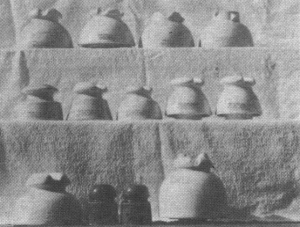
Starting with the top row, the first unit on the left (also see photo at top
of next page) is outwardly similar to the brown U-927B and, like the U-927B, has
a Fred Locke marking #6-3. However, the insulator is only a shell without inner petticoats or pinhole. There is a short petticoat-like
projection extending downward 1/4 inch inside the insulator around the 2-3/4
inch ribbed opening in the body. We can only guess that the opening was to
receive either a petticoat section to be glazewelded or perhaps a cemented in
sleeve. The insulator looks a little too crude to have met Fred Locke's
standards.
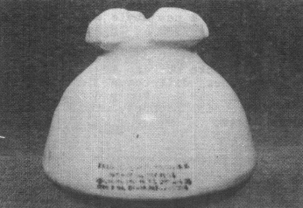
The next three insulators on the top row (l to r) are U-927A (5-1), U-925
(6-3) and U-925 (6-3). Again, all three are in pristine condition with excellent
ink markings.

On the far left of the second row in the group photo, is the new style
pictured below and it has been assigned U-941A (also see the photo below). It
has Fred Locke's ink marking #6-3. This insulator is very modern looking. In
fact, it is similar to the modern Locke style U-437 as well as the U-441 from
the 1901-1903 period.
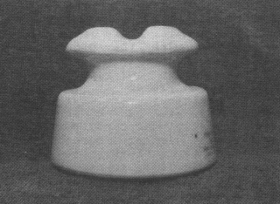
The next insulator to the right of the U-941A is also a new style and it has
been assigned U-939D. It has Fred Locke ink marking #6-3. The photo below shows
the U-939D alongside a U-447 with Fred Locke marking #0-2. There is an obvious
difference in size. The U-939D is a two-piece glazeweld and it is probably the
predecessor to U-447.

The other insulators pictured on the second row to the right of the U-939D
are (l to r) U-610A (6-3) U-939 (5-1) and U-939 (5-1). This is only the second
glazewelded U-610A with marking #6-3 that has been reported. The other was
reported in January, 1985 CJ.

The bottom row of insulators in the group picture are (l to r) U-927C
Imperial, U-3 (0-5), U-3 (0-5) and the new style U-928B. The photo at the top of
the next page shows the two brown U-3's to the left of a white U-3 (0-5) and a
white U-3 (6-3). The U-3's with underglaze ink marking are very rare.
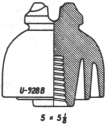
The U-928B (see photo on the next page) is very unusual. Where does this unit
fit in with the other insulators in the group? I have no doubt that the group of
Locke insulators were hand picked at the Locke plant and that they were never
used. Locke may have had a few Imperial insulators lying around from his
association with Imperial before he opened his plant in 1898. (Would he have
sold Imperial units, before 1898, so prominently marked with Imperial crown and wordy Imperial markings without at least his name stamped
"Manufactured for F. M. Locke..." or with one of his patent dates?)

At first, the U-928B looks very similar to Boch patent style U-928 made by
Thomas during that period (circa 1898). This unit is not marked, it has two ear
projections and obviously it is not glazewelded as are the Thomas units. It was
made by the dry process method and a superior example of that method as well.
Does the U-928B have any connection with the other insulators in the group? Fred
Locke did not produce insulators by the dry process method. Who was the
manufacturer? These questions will remain unanswered.
I am certain that you will agree that Bob did make a very important discovery
with this group of thirteen insulators. The Locke insulators appear to have been
hand picked, perhaps even by ole Fred, as fine specimens to exhibit the art of
making high quality porcelain insulators.
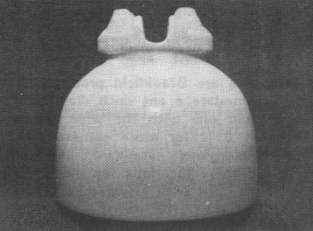
| 